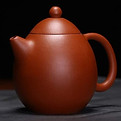GUIDE TO YIXING TEAPOTS
Standard Shapes
About
Yixing teapots have been around for quite awhile and the craft has given birth to a bit of standardization when it comes to the form of the pots. I’ve compiled some of the most recognizable shapes below. This is by no means an exhaustive list as artists produce new shapes everyday. This is simply the most common named shapes I have seen.The general theme, however, is that the shapes mimic things in natural life or Chinese culture. This shape list does not include any "masterworks" or teapots that are one of a kind and feature irreproducible intricacies. Below this are the 曼生十八式 or the 18 classic ManSheng teapot shapes as well as the Yixing Factory One Five Shapes.
_edited.jpg)
Shi Piao 石瓢
Shi Piao or “stone ladle” teapots are characterized by a trapezoidal shape much like that of a traditional carved wood dipper or ladle. They typically have a straight spout and triangular handle.

Xi Shi 西施
This teapot is named after one of the four legendary chinese beauties 四大美女 given in a concubine to king Wu in 450 BC. It is almost entirely spherical with a little nub of a spout and typical upside down handle.

De Zhong 德钟
Jing Lan 井栏
Both of these names are used for barrel shaped teapots with high spouts. Jing Lan means “Well fence” like the stone surrounding wall of a old water well.

Long Dan 龙蛋
This teapot, aptly named “dragon’s egg” resembles just that. It features an elongated egg shaped body and upward tilted straight spout.

Shui Ping 水平
This pot’s name translates to “level”. This is because this teapot is perfectly level from the top of the handle, across the rim of the opening, to the tip of the spout. You could lay a ruler down across those three points and it would make contact.

Mei Ren Jian
美人肩
“The beauty’s shoulder” describes teapots that have an upward pointing, arm shaped spout. The lids of these teapots also typically sit flush with the body of the vessel.

Fang Gu 仿古
These drums shaped teapots are considered a very standard and classic shape. The name “fang gu” translates to “something modeled after an antique or in the style of the ancients”. They feature a downward curved spout and interesting body contour.

He Huan 合欢
Xu Bian 虚扁
Both of these names reference very flat, almost squashed looking teapots with the spout coming out of the top side. He Huan can be a euphemism for making love which makes sense given that these teapots appear as two joined halves. These two names are very similar; the major difference is that Xu Bian are typically more rounded at the middle seam.

Qin Quan 秦权
These teapots are modeled after an ancient weighing implement called a Quan. The flat bottom shape and looped lid handle mimic the heavy iron weight.
Fruit and Vegetable
梨,南瓜,文旦, etc.
A popular trope in Yixing pottery is making teapots that resemble the shape of fruits or vegetables. The list of variations is endless and widely varied but here is a pear shape.
曼生十八式
Eighten classic teapot shapes as created by Chen HongShou 陈鸿寿 (Later ManSheng 曼生) a calligrapher and seal engraver in the Qing Dynasty. He created eighteen unique shapes all with engraved poetry. This effort has lead him to garnering the title of "The King of Chinese Pots" 中华壶王
1.“石銚” 2.“汲置” 3.“却月” 4.“横云” 5.“百衲” 6.“合欢” 7.“春胜” 8.“古春” 9.“饮虹” 10.“瓜形” 11.“葫芦” 12.“天鸡” 13.“合斗” 14.“员珠” 15.“乳鼎” 16.“镜瓦” 17.“棋奁” 18.“方壶”。

Yixing Factory One Five Shapes
宜兴紫砂工艺厂五形
Throughout Factory One's history they have held to five standard shapes. These shapes are pretty unique to Factory One and even varieties that share names like XiShi are very different in form.
1. Guava/ Xian Piao 芭乐/线漂
2. Magic Lamp/ Bian Deng/ Tang Po 神灯/汤婆
3. RouBian/ BianXia 肉扁/扁下
4. XiShi/ Bian Pu 西施/扁蒲
5. TaiJian 太监